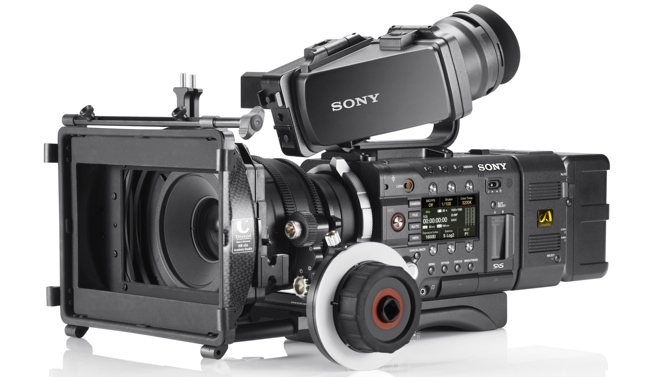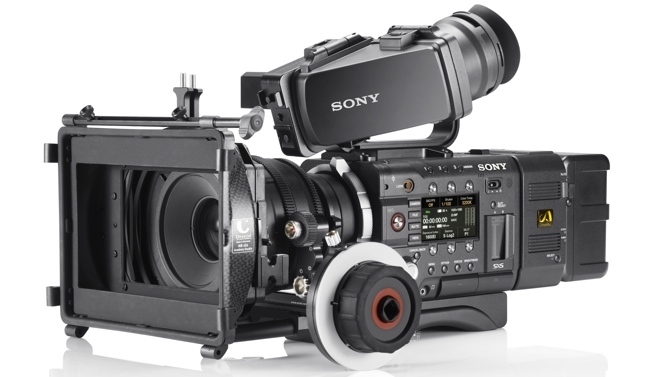
 Sony F55
Sony F55
Phil Rhodes holds an F55 for the first time and tells us where he thinks it fits in the digital cinematography marketplace
The new F5 and 55 are intended to fill in what Sony perceives as a gap in its range between the F3 and F65 - apparently, the F3 will endure. I have to agree that it's probably not unreasonable to want something more capable than an F3, but smaller than an F65, in the lineup.
It's boxy but good
The first thing that springs to mind about these new cameras is simply the shape and layout. Now, Sony tell us they're modular, although really if you take into account the fact that the lens, battery and viewfinder come off most cameras, what it really boils down to is that you can choose to mount, or not, the 4K recorder. Regardless, the straightforward rectilinear box is an approach that I suspect everyone except rig manufacturers wish Canon had taken with the otherwise excellent Cx00 series. The square box, and putting the menus on the side, are decisions that subtly, though powerfully, indicate that someone at Sony is paying attention.
Although it might seem a little unreasonable to start comparing the new "F" cameras to an Alexa on the basis that they've laid it out like an Alexa, that's pretty clearly the market Sony are going for with these things, As regards the pictures, the details of my non-gentle, non-forgiving opinion will have to wait until we've had one on test and looked at it both objectively and subjectively. Given the creditable performance of recent related devices from Sony, such as the FS700 which is quiet for its price even at high frame rates, and the F65 which may be the best video camera in the world, we can reasonably hope for nice results from the F5 and particularly the F55.
Global
In the meantime there are are a few features that stand out. The F55 has a proper global shutter, which I sincerely hope will be the start of a trend moving sharply away from rolling-shutter cameras in general. Rolling shutter is a real pain in the neck not only because it can distort the image but also because of its behaviour with fast phenomena like xenon strobe flashes and flickering fluorescent tubes, and my biggest complaint about the F3 is that it has less than ideal performance in this regard. I worry slightly about what engineering compromises may have been made to achieve this as there are traditionally tradeoffs in noise-floor and dynamic range in order to achieve global shutter on modern sensor designs, but we'll find out about that in a bench test with some charts.
High frame rate
It's also very welcome to see the availability of high frame rates rolling out to what should be more affordable cameras. Of course the FS700 is still the baby of this particular range and provides rates up to 240fps, which makes the decision to limit the F5 to 120fps slightly surprising. I believe the F55 may be the only conventional camera to provide a Bayer 4K raw at 240fps, which, if you're comparing (and we are), significantly exceeds the capabilities of the presumably competing Canon C500.
Priceless
I say that the C500 is presumably a competitor to F55 on the basis that Sony haven't announced prices yet. Reevaluating that thought I realise that the F55 is likely to be somewhat more expensive than C500, and it will be interesting to see how the Canon and Sony ranges compare. It is slightly frustrating to attend a launch such as today's and not be given even a vague idea of price, on the basis that it's possible to build almost any imaginable camera if the budget is unlimited, and the usefulness of these things is heavily dependent on their affordability. If F55 costs $20k, it's probably great. If it costs $100k, it's irrelevant. Trying to figure out the absolute worth of the thing by interpreting a spec sheet absent the price is pointless. The only information we were given was “between F3 and F65”, which doesn't really tell us much.
Multiplying media
My only reservation is about the new AXS recording media, which is yet another incarnation of flash storage designed to support the high bit rates of the 4K raw modes. I have no intrinsic problem with this particular device or the way it's designed, but I am concerned over the explosive growth of different media formats and codecs. Sony alone are currently selling or promoting four different flash formats: Compactflash, SxS, AXS, and SR Memory, five if you include Memory Stick, six if you include the new high-speed SxS cards mentioned today. I appreciate this is to some extent mandated by technical requirements – you couldn't record an F65's raw output on a memory stick with any useful amount of quality – but four, five or six different formats seems more than would reasonably be required to provide a selection of performance grades. In a world where a camera system's life as a popular rental item is probably less than two years, it'd be much better if the expensive flash storage was usable for two or three cycles, as opposed to practically every new release requiring a new thing. The new AXS cards are required only for high bitrate and 4K raw recording, but even the internal SxS slots require new high-performance media in some circumstances. Given the company's willingness to create speed grades within existing product lines, I wonder if the AXS recording system couldn't simply have been a lesser variant of the existing SR Memory range. This isn't an absolute roadblock of a problem, it's just a frustration, and I hope and expect to see this sort of thing calm down a bit as flash recording becomes less recent an invention and standards start to emerge.
Considerable quantities of codecs
Codec compatibility, likewise, is a common problem. The F5 and 55 valiantly attempt to solve this problem by offering a blizzard of options, from MPEG-2 at 50Mbps for everyday work to the SR codec on AXS cards at the high end. Sony have chosen to add a new option they call XAVC, which provides for high frame rate HD and internal 4K recording on the F55. All of this is fine at some level, but while all these options can help solve problems, particularly for the owner-operator with various clients, this is in some ways a problem that was actually created by excessive codec diversity in the first place. There's not even a particularly convincing technical reason for it, since many of these codecs (including the MPEG-4 profile used by SR, and XAVC) are based around similar standards anyway. All manufacturers do this to some extent.
In conclusion: they're good
In general, though, I like these new cameras. They're built to be filmmaking tools, not overgrown DSLRs, and they're reassuringly (even startlingly) heavy, as befits something that's solidly built. They have all the right connectors with not an RCA plug or flimsy DC jack in sight. The removable top handle is a minor but creditable feature. Ultimately, as I say, until we get one on a test bench, then go out and shoot something real with it, and until we have prices, it's all guesswork, but initial impressions are good.
Tags: Production



Comments